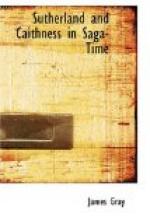The diocese of Caithness, which then was co-terminous with the earldom and comprised all the above districts which now form the modern counties of Caithness and Sutherland, had in 1165 been in existence for about thirty-five years; its chief church being at first at Halkirk in Caithness and thereafter being the old Church of St. Bar at Dornoch, but it was scantily endowed, and therefore its clergy were but few.[31] Its Bishop was Andrew, a Culdean monk of Dunfermline, and probably Abbot of Dunkeld, who had been promoted to the see of Caithness before 1146, and died at Dunfermline on the 30th December 1184. Ingigerd, Earl Ragnvald’s daughter, would at this time be a young wife and mother living with some of the elder of her six children, probably near Loch Naver, on part of the Moddan family lands there with her husband, Audhild’s son Eric Stagbrellir, until their sons, Harald Ungi, Magnus, and Ragnvald, should grow up. But these sons, possibly on their father’s death, and certainly before 1184, when young Magnus Mangi was killed[32] at the battle of Norafjord, emigrated to Norway to obtain the Orkney jarldom about ten or fifteen years after King William’s accession; while of Ingigerd’s daughters, Ingibiorg, Elin, and Ragnhild, nothing is recorded at this time, though Ragnhild appears later on, and one of her sisters is believed to have married Gilchrist, Earl of Angus during the last twenty years of the twelfth century. The other may have married in Norway, or died young and unmarried.
All these children and their descendants successively according to sex and seniority would have claims as being of the line of Erlend Thorfinnson, to half the Caithness earldom and Jarl Ragnvald’s lands there, claims which, however, it would be impracticable, while Harold Maddadson lived, to enforce.
Harold Maddadson’s children by his first wife, namely Henry of Ross, Hakon, Helena and Margaret would, in 1165, all be born, but would be well under twenty-one, while of his second family, if Gormflaith was born by 1135, which is unlikely, his eldest son, Thorfinn could have been born, and some of the others. Thorfinn is mentioned by name in a grant[33] of a silver mark per annum to the Church of Scone issuing out of Harold’s lands, of which the date is after 1166, but no one can say how much before the 30th December 1184, the date of the death of one of its witnesses, Andrew, Bishop of Caithness.
If the union with Gormflaith took place after 1174, no child of that union would exist until 1175. That this is in fact true is rendered more probable because their union is not mentioned in the Flatey Book until after the death of Sweyn in 1171. But the passage is of doubtful authenticity, (see Rolls Edition p. 224), and inconclusive even if genuine. From the various allusions to Harold’s union with Gormflaith, it would seem that Harold lived with her before he married her for many years, but married her legally after his first wife Afreka’s death after 1198 when William the Lion stipulated that he should take Afreka back, and the subsequent legal marriage might in those days, under the Canon and Roman law, suffice to make Gormflaith’s children, though born in adultery, legitimate and capable of succeeding to the earldom (see Dalrymple’s Collections, p. 221).




